
Eye Wounds and Surgery Page Menu: 1 2 3 4 5 Next>>
Eye Wounds and Surgery During the Golden Age of Piracy, Page 3
Wounded Eye Surgery - Humors
Many of the problems with the eye seemed to
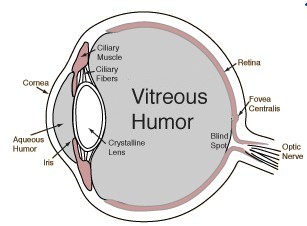
Parts of the Eye featuring several humors
golden age of piracy peiod surgeons to tie into humoral theory. The body's humors generally were thought to have liquid or viscous forms and the surgeons recognized that the eye contained fluids. Because humors could be good or ill, a problem with the eye was likely due to the influence of bad humors. Ambroise Paré noted that many times during the eye healing process that "acrid humors of the eye are poured out."1 He further explained that "the coat Adnata often swells so much by reason of a wound or some other injury, and stands so forth by the falling down of humors, access and mixture of flatulencies, that it hides the whole Pupilla, and hangs forth of the eye-lids, like as if it were an unnaturall fleshy excrescence, and it looses the native colour, and looks very red, so that the eye can neither be shut nor opened."2 He felt swollen eyes were caused by bad humors.
While humoral theory has long since been proven to be false, you will still notice that the names of some of the parts of the eye still hearken back to it as can be seen in the simple diagram above left.
1 Ambroise Paré, The Workes of That Famous Chirurgeon Ambroise Parey, p. 292; 2 Ibid.
General Bleeding and Purging
"Pains of the eyes are removed by drinking pure wine, or the bath, or a fomentation, or venesection [bleeding], or purging." (Hippocrates, Aphorisms, p. 141)
The favored way to remove bad humors was by the old standbys of purging them (either upward - by
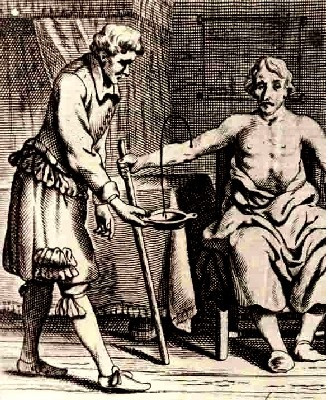
encouraging vomiting through the use of emetic medicines - or downward - by using enemas.) The father of
medicine's aphorisms were still widely taught at this time and his dictum was firm on this point in particular. Sea Surgeon John Moyle advised, "In Opthalmias, Inflamations, and Suffusions of the eyes, (if Age and other circumstances will permit) 'tis best to let blood plentifully in the Saphalick Vein, (if fair) or that which appears best. In the next place give such [emetic] Purges as will carry forth that hot and cholerick humour that thus afflicts the eyes."1
John Woodall agreed, saying eye wounds were "dangerous by reason of their affinity as well with the Pericranium as the other Membrans of the braine, so that they are for the most part full of bitter paine, causing losse of sight"2 and so the patient should be bled and purged through 'glysters' (enemas).
Likewise, sea and army surgeon Richard Wiseman used both at the end of one of his cures. For a woman who had been struck in the face causing damage to her eye, he said that on the second day "I let her bloud, taking away about 10 ounces with a rotten Serum upon it [the blood]. The next day she was purged, this was done for the carrying off the flux [flow] of humor from her Eye and Face; thus was she Cured"3.
John Moyle used bloodletting in a case described in his Memoirs for a patient with a wounded eye. "I opened a vein to make revulsion; this Dressing continued on 48 Hours, and then being removed, the Eye was found kindly digesting, and at a Dressing or two more Agglutinated [the wound edges healed together]."4 Revulsion meant bleeding a person from a place opposite the area where the blood was forming bad humors so that the bad humors could be drawn away.
1 John Moyle, The Sea Chirurgeon, p. 246; 2 John Woodall, the surgions mate, p. 138; 3 Richard Wiseman, A Treatises of Wounds, p. 58; 4 John Moyle, Memoirs: Of many Extraordinary Cures, p. 40
Bleeding the Eyes
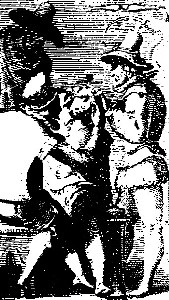
From the French Chirurgerie
by Jaques Guillemeau (1612)
Most period surgeons were content to bleed patients in the normal way - by 'breathing a vein', usually in the arm or, for the more adventurous, possibly in the temple. However one of our surgeons, Lorenz Heister, recommended
a more audacious method - bleeding the veins of the eye itself. I should note that he is the only surgeon to recommend such a method. Most sea surgeons would not find the conditions on the ship conducive to such a delicate operation. The ship was usually in motion in one way or another and the surgeon's operating platform on the orlop deck was dim. A slip of the blade and the patient could lose his eye completely. So bleeding of the veins of the eye was probably not done shipboard.
Heister mentioned several symptoms that could be helped by bleeding a patient in this way. These included eyes that "are inflamed, that is, when the Blood-vessels, spent on the White of the Eye, appear much larger and more numerous than usual; wherein it will often succeed, when other Medicines, and even Phlebotomy [normal bloodletting], have been tried without their due Effects, and when the Inflammation runs to such a height as to endanger the Sight."1 He also advised its use when a red film appeared on the eye, "for the oftener the Vessels are incised, which nourish the Film, the sooner it will shrink and disappear."2
His procedure for cutting the veins of the eyes is quite lucid, so I will repeat it in full.
First, the Patient is to be seated, conveniently on the Bed-side, or on a Chair, with his Head held in a proper Posture by an Assistant; which done, the Surgeon makes a transverse Incision with a Lancet upon the turgid small Veins in the Corner of the Eye, so as to open them, or cut them quite asunder. Some use a small pair of Scissars, instead of a Lancet, to divide the Vessels; but, in using either of them, the Eye-lids must be held apart from each other by the Fingers of one Hand, while the Vessels are incised by those of the other. Some, again, elevate the small turgid Veins with a crooked Needle before they divide them, the Eye-lids being in the mean time held asunder by an Assistant. But it would be still better to have these crooked Needles made thin and double-edged, so that they may divide the Vessels of themselves in Elevation, without the Use of Lancet or Scissars.3
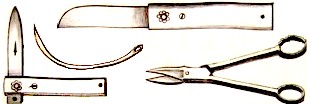
Lancets, Small Scissors and a Crooked Needle, taken
from
Cornelius Solingen's
Alle de Medicinale
Heister finishes the operation explanation by advising that the once the veins are cut, "their Discharge of Blood should be promoted by Fomentations of warm Water, or a Decoction ex. Euphrasia Hyssop. Veronica, &c. frequently applied to the Eye by means of a Sponge, or soft Linen Rags."4
He notes that the operation can be repeated, but adds a most telling comment. "I must indeed confess, that after having performed this Operation myself on several Patients... I could not possibly prevail on them to have it repeated, and it was with the greatest Difficulty that they were persuaded to it at all; some being deterred from it by fear of losing their Eye-sight, and others upon the account of the great Pain which it must necessarily inflict on this tender Organ."5 This suggests that the operation would not be widely used even on land.
1 Lorenz Heister, A General System of Surgery in Three Parts, p. 377; 2 Ibid.; 3 Ibid.; 4 Ibid., p. 378; 5 Ibid.
Cupping for the Eyes
Cupping was the process of putting a match inside of an open-ended globe to burn all the oxygen out
of it and then placing the cup upon a body part. As the cup cooled, a vacuum was created
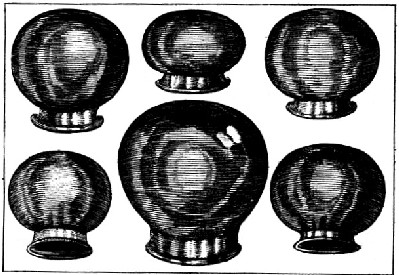
Various types and sizes of Cupping Glasses, Table 1 in
Exercitationes
Practicae Circa Medend Methodum by Frederici Dekkers
drawing the bad humors to the surface of the skin. It was called dry cupping when used upon regular skin and wet cupping if incisions were made before the cup was placed. (Wet cupping encouraged blood from the incisions.) French surgeon Pierre Dionis and sea surgeon John Woodall both recommended cupping for wounds of the eyes.1
Your first thought might be that the eyes were somehow cupped, which sounds like a pretty grisly operation. Fortunately this is not the case; period surgeons believed that the humors that affected the eyes run through the back of the neck. The noted 12th century Arabic surgeon Albucasis gives us the proper procedure for cupping in the case of eye troubles. Like Galen and Hippocrates, Albucasis was thought to be one of the Ancients - surgeons whose works were so well regarded that they were still taught during the golden age of piracy.
The effect of cupping the nape of the neck is to help in heaviness of the head and in a fluxion of humours into the eyes; but it should be done after a complete evacuation [purging upwards and downwards] of the body. This use of cupping make take the place of venesection of the cephalic vein [bleeding using a vein in the arm.]2
1 Pierre Dionis, A course of chirurgical operations: demonstrated in the royal garden at Paris. 2nd ed., p. 472 & John Woodall, the surgions mate, p. 136; 2 M.S.Spink and G.L. Lewis, Albucasis On Surgery and Instruments; A Definitive Edition of the Arabic Text with English Translation and Commentary, p. 658
Setons
The most universally recommended surgical procedure for the treatment of humors of the eye was the installation of a seton in the back of the neck. Ambroise Paré recommended that "if we cannot prevail by all these formerly prescribed medicines fit to stay the defluxion [stop the flow of humors to the wounded eye], then it remains, that we apply a Seton to the neck; for it is a singular remedy against inveterate defluxions into the eyes."1 Sea surgeon John Moyle advises that setons "are not to be neglected" in these cases.2 Matthias Gottfried Purmann states that setons (which he calls 'fontanels') are used "with good Success in all Distempers of the Eyes... where they perform many great Things, and as soon as the Patient is recovered, they dry them up again, and consider nothing further in the Matter."3
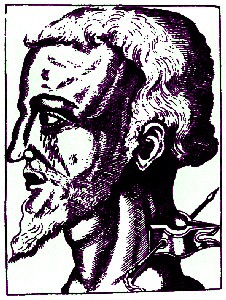
Seton for a Running Eye
Georg Bartisch (1583)
Paré reiterates their usefulness by telling the story of Paul, an Italian Goldsmith "who dwelt neer the Austine Friers."
For he having used many medicines of divers Physitians, and Chirurgeons in vain, when he was almost blind, he applying a Seton, by mine advice, began by little and little to see better according to the quantity of the matter which was evacuated, untill at length he perfectly recovered his sight. But at last growing weary of the Seton which he had worn for a year (although matter came dayly forth thereof) yet he would have it taken forth, and healed up; but this way of evacuation being shut up, and the humor again beginning to flow into his eyes, so that he was in danger to become blind, he called me and made me again to apply the Seton in his neck. Whereby recovering his former soundness and perfection of sight, he yet wear the Seton.4
Jacques Guillemeau gives us a splendid (if somewhat unusually spelled) outline of the tools that were used to install a seton. (The spelling can be blamed on Guillemeau's interpreter who hides behinds his initials - A.M.)
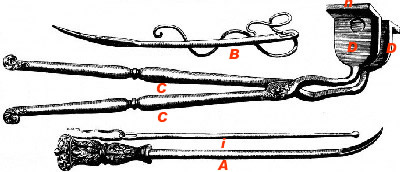
Seton Instruments, from The French Chirurgerye
by Jacques Guillemeau,
p. 25 (1612)
"A. Demonstrateth a trianglede Cauterye, to apply therwith a Seton, which both piercethe, & cuttethe: the which Cautereye is applyede cleane through the perforate[d] tonge [C], ortenacle, wherewith the skinne of the Necke is apprehendede, for the Seton to passe throughe.
i. The Needle for the Seton, or transoratione.
B. An other Needle for the same intente, and purpose, wherewith we transforate the skinne without the tentacles, or tonges.
C,C. The tonges for the Seton, which ar pearcede, to thruste there throughe the Seton.
D,D. Two holes, which must adjoyne unto the reflectione, which is noted with n. The reflectione which is notede, & which is made because the hott Cauterye, shoulde not chaunce to touché the skinne of the Necke."5
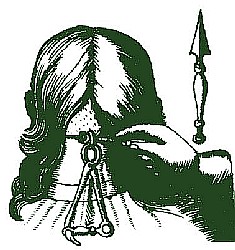
Seton insertion, from Johannes Scultetus'
Armementarium Chiurgicum, p. 111 (1665)
For the operation, Matthias Purmann tells us the "only Difficulty in making an Issue in the Head, is in making choice of a proper Place, for otherwise it will signifie very little."
In order whereunto observe this Method: First, take off the Hair about the breadth of a Crown-piece, from the Crown of the Head to the place where the Satura Coronalis [coronal suture - the joint separating the frontal and parietal bones of the skull] and Sutura Sagittales [sagittal suture - the joint between the two parietal bones of the skull] meet; and having found it by feeling about with your Finger, make your Issue there; but if you cannot find it by this Method, and the proper place being all in all, then take a strong Thread, draw it from the tip of the Nose to the hinder part of the Neck, then take another Thread and draw it over the Head in a strait Line, from the middle of one Ear to the other; mark the place where the Threads cross one another, and you have found the Place where you ought to make the Fontanel [or place the seton].6
Paré outlines the procedure itself, making "the Patient to sit on a low stool, and to bend down his head, that so the skin and fleshy panicle may be relaxed"7. Next the skin is plucked up by taking "hold of as much hereof as you can with your pincers [see instrument C,C/D,D in Guillemeau's sketch above], not touching the muscles of the neck for fear of a convulsion and other
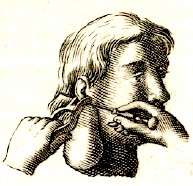
Seton Insertion from Jacques
Guillemeau's The French
Chirurgerie, p 152 (1612)
symptomes". With a firm hold on the pincers, "you shall thrust the hot [cautery] Iron
[instrument A in Guillemeau's sketch] through the holes made in the midst of them... The wound must be made or burnt in long wayes, and not thwarting, that so the matters may be the better evacuated". Paré notes that "the cautery or hot Iron must have a three or else a four-square point & that sharp, that so it may the more easily and speedily enter." Guillemeau's instrument diagram above specifically shows this.
"Then keeping the pincers immoveable, let him draw through the passage made by the cautery a needle thred with three or four doubled thred of Cotton (or rather a skean of silk) moistened in the white of an egge and oyl or Roses; then after you have applied pledgets [small pieces of lint] dipped in the same medicine, bind up the part with a convenient ligature [strand of silk or linen material]."
The day following the neck must be anointed with oyl or Roses, untill the ulcer cast forth much matter; then you shall anoint the Cotton thred with [a turpentine-based medicine]. Which you shall use so long, as you intend to keep open the ulcer. For it hath a faculty to draw the humor from the face, and clense without biting."
Paré has an interesting suggestion that would avoid a great deal of the patient's discomfort. "I have found not long since by experience, that the apertion made with a long thick Triangular needle of a good length like to a large pack-needle, is less painfull than that which is performed with the actuall cautery, which I formerly mentioned. Wherefore I would advice the young Chirurgeon, that he no more use the foresaid actuall cautery. I have given you the figure of the needle."8
 Seton Needle recommended by Paré, from his book The Workes of that Famous Chirurgeon Ambroise Parey, p. 292 |
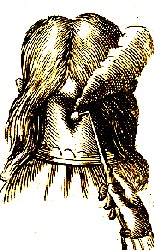
Scultetus'
Armementarium
I mentioned that Purmann talks about Fontanels as opposed to Setons and
that it was a broader term for the basic process. The purpose of a seton is to irritate the skin and create an ulcer that will allow 'bad humors' to run out of it. While most of the period surgeons suggest setons, Purmann explains there are other ways that this can be accomplished. He details one that makes for a nice closing bit to this surgical discussion.
...in Italy and France they commonly use Actual Cauteries, which are Irons made with a small round Head in Form of an Acorn, which being made very hot, and the Skin touched with it, where you design to make the Fontanel, it will raise a Blister, which being cut, and a Pea put into it, with a thin Piece of Silver upon the Pea, and Bolsters and a Bandage over the Silver Plate, to make the Pea work its way downward; let it continue so for two or three days, and at the next opening you will find the Issue made.9
1 Ambroise Paré, The Workes of That Famous Chirurgeon Ambroise Parey, p. 292; 2John Moyle, The Sea Chirurgeon, p. 246; 3 Matthias Gottfried Purmann, Chiurgia Curiosa, p. 21; 4Paré, p. 292; 5 Jacques Guillemeau, The French Chirurgerie, p.24; 5 Purmann, p. 21-2; 7 All quotes from the seton insertion procedure are from Paré, p. 292; 8 Ibid.; 9 Purmann, p. 22

